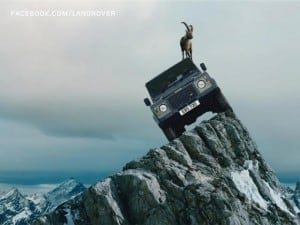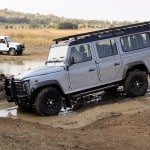
Despite the fact that Land Rover is now owned by Indian super-manufacturer Tata, there will always be something quintessentially British about the engineering excellence of this brand. An association that’s clearly underlined by the appearance of the new Land Rover 110 Defender in the 2012 James Bond film Skyfall. Fans of both the car and the secret agent can pick up one of these double cab vehicles, which feature in the high-octane opening scene of the film, for an absolute snip at $85,000 on eBay.
Land Rover first started life when Maurice Wilks, chief designer at the Rover company, was inspired after messing around with an American Willys Jeep, left behind in England after World War II, on his farm in 1947. He was so impressed with the work-horse like capabilities of this vehicle that he decided to build his own version, and the idea of the Land Rover slowly took shape.
Wilks wanted the Land Rover to have the ability to operate as a power source able to drive things, with a range of bolt on accessories, and thus the plans were made for the first vehicles. Due to a huge shortage of resources following the war, some of the first test prototype engine and drive systems actually had to be mounted onto a Jeep chassis. Still, the company embraced the challenge and created a design that could be easily manufactured, eschewing steel bodywork for easily folded aluminium panels where possible, and the first ever Series 1 Land Rover was born 65 years ago in 1948.
Since those first days a number of different ranges of Land Rover vehicles have been produced. The most famous is possibly the Land Rover Defender series, initially launched in 1983 as the Landrover Ninety and Landrover One Ten, where the numbers represent the length of the wheelbase in inches. These two cars managed to overturn a huge decline in sales that took place in the early 1980s. Remembered for its classic blue colour scheme and familiar boxy shape, this was the car that bought back success to Land Rover and helped modernise their production and marketing. This car is still available in a modern form today – as we mentioned it can be seen in the latest Bond movie, and is one of the most enduring vehicles of all time.
We couldn’t talk about Land Rover without mentioning their own brand of top-end SUV, the superb Range Rover vehicles. These cars were not originally designed for the luxury market, although if you look at the latest fourth generation models, such as the Vogue and the Evoque, you would never guess this was once the case. These new models are a far cry from the original Range Rovers, which were actually produced with vinyl interiors, so that the entire inside of the car could be hosed down if necessary. An indication that Land Rover originally intended these cars to be utility vehicles in line with the original ethos of the company.
According to the manufacturer, it is estimated that around 60-70% of all Land Rovers sold in their 65 year history are still on the road today. This is a testament to the original build quality, design excellence and the ease with which the car can be repaired. The company did experience a tough time in the early 2000’s, when it looked like they might not be able to keep up with modern design and passenger comfort requirements, but that all changed following the purchase of the Land Rover by Jaguar, who are in turn owned by Tata. Together they’ve brought the company up to scratch with 21st century passenger comfort requirements and ride standards.
So what’s next for Land Rover? This classic car company seems to have done it all already – are there any new fields for this classic car manufacturer to conquer? We believe that the coming years will see their Range Rover line become more popular in the US and emergent Asian markets as both a functional family car and a status symbol. At the same time, we hope that the classic Land Rover Defender never fades away as this car is probably a staple of all human civilisation everywhere. We would like to see this car, or a very similar version of it, available at the next big milestone for Land Rover, and hopefully even in another 65 years.






.png)